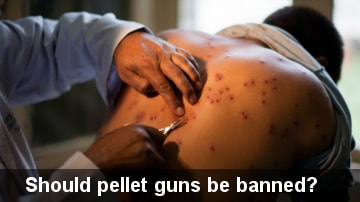
Should pellet guns be banned?
The unrest in Kashmir has always been lethal, claiming hundreds of lives and injuring others. The protest by civilians has often been ugly and Central Reserve Police Force (CRPF) had to take actions to prevent them from spreading further. 2010 saw the first deployment of pellet guns to avoid fatalities on civilians.
Recently when civilians and army clashed, the usage of pellet guns became the highlight of controversies. Children as young as 12 years old were injured which led the government to reconsider if pellet guns are more harmful that useful for restoring peace in an area of clash or unrest.
Yes :1. Lethal : Though they are mainly meant to induce pain and work quite well over short ranges of up to 500 yards, yet when fired from close distance, they prove to be extremely lethal. Sensitive areas of the body like eyes could get hit and get permanently injured, crippling the civilians for the entire life. Pellet guns are notorious for penetrating soft tissues.
2. Alternatives : To restore peace and bring a notorious situation under control, non-lethal alternatives should be put to use, the ones that cause pain but not permanent injuries. Increasing the intensity of tear gas is one such option that should be considered. Usage of chili powder and rubber bullets could also be proposed as opposed to pellet guns.
3. Disaster : Reports suggest that hundreds of people in Kashmir are being treated for serious eye injuries like “multiple structural damage.” 1.3 million Pellets are known to be used by CRPF in 32 days. In such a large scale, the so called non lethal means of controlling a crowd is bound to cause disaster.
4. SOP ignored : The deployment of pellet guns calls for following standard operating procedure, which according to CRPF was impossible to be followed since the nature of protest had people moving, bending and running around. They are to be shot below the waist but that became difficult with people bending to dodge the pellet. If they are not safe, it is best to stop using them altogether and look for alternative methods.
5. Why only in Kashmir? India has witnessed communal unrest and such protests in many states over the years, some even more lethal to the extent that police had to step aside for hours. In none of the states when civilians protested against police were these pellet guns deployed. Why should Kashmir remain the only state that is excluded from safety first measures?
No:1. Safety : Keeping in mind that pellet guns are short range guns, it is evident that you do not get injured unless you go near them. When there is curfew in the area and you are supposed to stay indoors, civilians still go out, pelting stones at army personnel and in turn return injured by pellets.
2. Safety of children : There have been reports of children as young as 12 being injured. But the same goes for children. People have to stop trying to use children as shields. They wouldn’t be getting injured if they stayed at home instead of openly participating in things that should be kept out of the innocent minds of children.
3. When mob goes wild : As many as 1022 CRPF men were injured this year due to civilians pelting stones at them. When mob resorts to lethal means, they cannot be allowed to do so just because they bring along women and children to be used as shields. They are to be taught the strict lesson that if they go against the law, actions will be taken, no matter how many they might be.
4. Bullets : If pellet guns are banned, CRPF would have to open fire with bullets when the situation goes out of hand. That is bound to take lives and cause more casualties and fatalities that the present day alternative.
5. Risking the lives of those who secure the lives of millions : CRPF risks their lives to secure the lives of millions of Indians. They get injured in large scale too. Banning pellet guns would be a compromise to their already dangerous scenarios of life. Whatever alternative is thought of, it would not be as appropriate as the pellet guns are.
The case is in court and the hearing is still pending. We can hope that an alternative could be designed that induces fear of law and order among civilians along with not compromising the security of armed personnel trying to bring the situation of these areas under control.
The situation is political, no doubt, but those injured are always victims, be it the civilians or the armed personnel. We could only hope that a political dialogue between the central and state could be initiated to put an end to this kind of clash between people and CRPF.